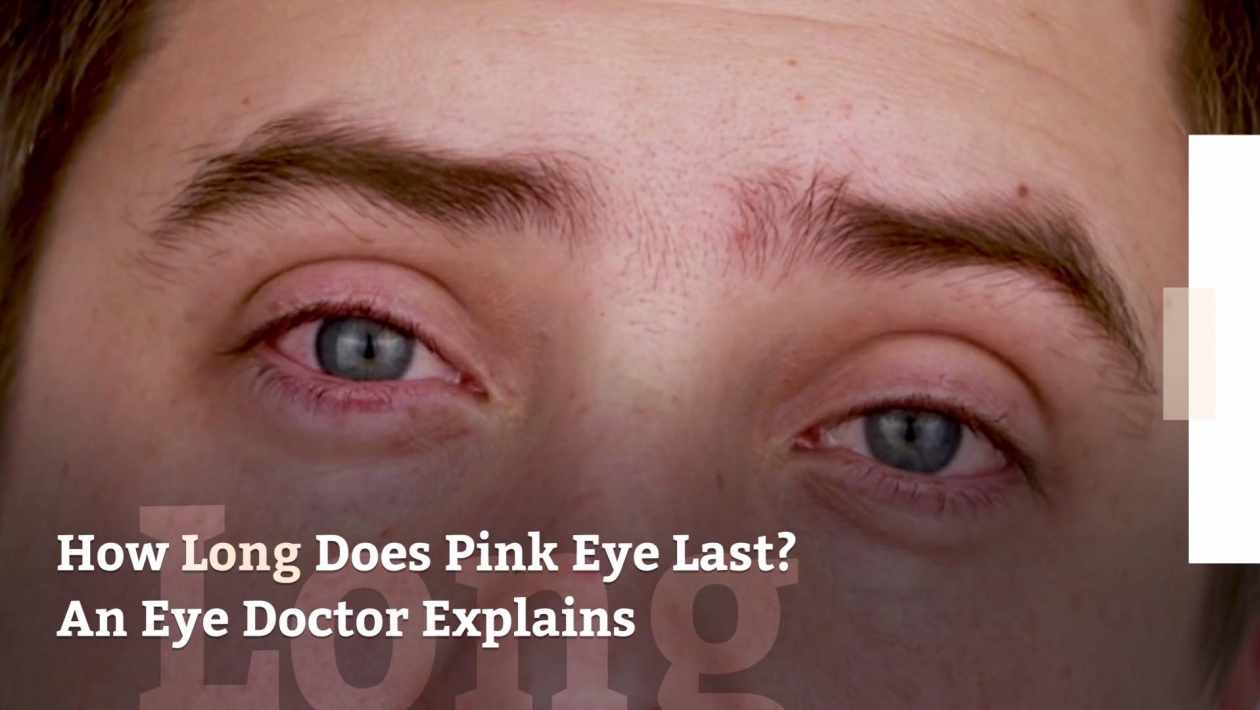Pink eye or redness in the eye is a fairly common eye problems. However, many people are worried about how long does Pink Eye lasts. Nothing to worry about. It lasts for a few days, then heals. In medical term pink eye or redness in the eye called conjunctivitis.
There are many possible reasons for redness in the eye or pink eye. In this post, we look at the most common causes of itching and irritation associated with red eyes.
How long does pink eye last?
Conjunctivitis is generally a short-term illness. However, symptoms may last longer or shorter, depending on the cause of the conjunctival inflammation and whether it is being appropriately treated. Therefore, the duration of the conjunctiva’s inflammation will depend, to a great extent, on a correct diagnosis and adequate treatment.
How much time are we talking about? Let’s look at each of the possible situations:
Irritation conjunctivitis
The duration is usually a few days, depending on the severity of the irritation.
Viral conjunctivitis
They are the ones that can last the longest, but there is no exact calculation of this time.
As a general rule, the patient usually worsens one week after the first symptoms appear. These are typically present between one and two weeks but can manifest themselves for a month.
The ideal is to follow the ophthalmologist’s indications to avoid that the duration is longer and that the side effects prolonged in time.
We must bear in mind that viral conjunctivitis is not exclusive to the autumn or winter months. It can also occur in the year’s hottest time, especially when there are sudden temperature changes and the weather is more unstable.
Also, when only one of the two eyes is affected, the most common is that after a few days, the other also presents the characteristic symptoms of this disease.
Different reasons for pink eye: How long pink eye last?
Reason 1: an eye infection (such as conjunctivitis)
If you have a red eye, you may have had an infection called conjunctivitis. This highly contagious eye disease, also known as pink eye, is undoubtedly one of the most frequent. Conjunctivitis occurs when the conjunctiva (the transparent part on the eye’s surface) becomes infected. It irritates the blood vessels in this regard. It is the inflammation of these vessels that gives the eye a bright pink tint.
You know it’s not pleasant at all. But don’t worry: there are treatments for conjunctivitis. Consult your optometrist for more information. He will be able to prescribe eye drops specially designed to give you relief. If you want to learn more about this annoying infection, we invite you to read this post. It deals, among other things, with conjunctivitis.
Reason 2: dry eye
Red eyes are also a symptom of severe dry eye. They can even indicate a condition called dry eye syndrome. This syndrome manifests itself in people whose tear glands have insufficient production, which results in eyes not producing enough tears. Artificial tears and some eye drops can improve your comfort, but only temporarily. In general, you should consider reducing the amount of time you spend in front of the screen. This simple change can help relieve your symptoms and be effective against redness and itchy eyes.
Although dry eye syndrome is not entirely treatable, you can manage it with the correct dosage of drops. There are also surgical solutions: an ophthalmologist can insert a small biocompatible tear plug. It is into the tear ducts opening to block drainage and promote tear production. For more information about these two solutions, talk to your optometrist or ophthalmologist.
Reason 3: allergies
No one is happy with seasonal allergies. Not only do they cause an itchy throat and endless sneezing. But they also cause redness in the eyes and watery eyes. Red eyes are often a sign of an allergic reaction triggered by allergens. It is presence in the air (such as pollen or dust mites). Or by contact with animal dander.
When we ingest food that our body considers potentially dangerous, it begins to release histamine. That is the same reaction triggered if an allergen comes in contact with our eyes. And it causes itchy and red eyes.
Many try to relieve their allergy symptoms by rubbing their eyes. But we recommend that you resist this temptation to make your situation worse. You can find out more about the adverse effects of rubbing the eyes here. Instead, try applying a warm compress to your eyes until the symptoms become tolerable.
Reason 4: excessive contact lens wear
The contact lenses may be an unnecessary hassle. Putting represents a further step in our morning routine. And it takes time to remove by the end of the day. They require a lot of care from us. It’s perfectly understandable to tempting to skip this step and go straight to bed. It is with your contact lenses still in your eyes. However, neglecting to remove them can cause chafing, irritation, and redness. If you keep your contact lenses longer than recommended. The consequences could be even worse, you could get a severe infection. Therefore, it is preferable to take good care of them. And remove them at a reasonable time or consider an intervention like LASIK to simplify your life.
Reason 5: cigarette smoke and cannabis pink eye last
Smoking is terrible for your health for many reasons. But did you know that this bad habit can also affect your vision? Indeed, being in regular contact with cigarette smoke over the long term can damage your eyes. Cigarette smoke can cause redness in the eyes, especially in contact lens wearers, whose eyes are easily irritated. Also, smoking contributes to the decrease of moisture in the eye.
Cannabis smokers do not run away from it either, as using it can also cause redness in the eyes. However, the cause of this redness is different: it manifests itself due to a change in intraocular pressure. The endocannabinoid psychoactive ingredient in cannabis, THC, lowers blood pressure. As a result, intraocular pressure drops, and the blood vessels and capillaries in the eye dilate. That is why the use of cannabis has such an effect on the appearance of the eyes.
Reason 6: contact with chlorine (or other chemicals used to clean swimming pools
You should always remove your contact lenses before going underwater (including showering). By keeping them, you run the risk of contracting a nasty infection, in addition to having itchy and red eyes.
Reason 7: fatigue
In addition to making us lazy and unmotivated, fatigue can give us red eyes, which is a particularly undesirable effect. The most effective way to take care of tired eyes is to get a good night’s sleep.
Reason 8: glaucoma, a worrying cause of pink eye last redness
Glaucoma is an eye disease usually associated with age, the symptoms of which appear slowly but steadily. If your eyes are a bright red tint, you may have glaucoma. In this case, it is essential to get medical attention as soon as possible. Please find out more about glaucoma and its impact on vision here.
Reason 9: red eyes in photos
Although it is not a disease or a vision disorder. You may have already noticed that your eyes sometimes appear red in some photos. Are you wondering what the explanation is behind this phenomenon? This is called the red-eye effect, and what it is might surprise you.
When taking a photo using the flash, the camera emits a lot of light. This function makes it possible to illuminate what you want to photograph. And if your subject is a person or an animal, the red-eye effect may occur. Sometimes this intense light can enter through the pupil and bounce off the back of the eye.
The red that then appears in the photo is blood. This blood found in a part of the eye called the choroid, which supplies the retina with oxygenated blood. Fortunately, there is a lot of photo editing software that can help you correct red-eye.
Here’s how to stop having pink eyes: How long pink eye last?
In addition to the items mentioned above, there are many ways to help you get rid of eye inflammation. And the redness that comes with it. If you’re finding for a primary treatment or don’t need to get on to the optometrist, here’s what you can do:
- As mentioned earlier, apply a warm compress to your closed eyes to increase your oil production and moisten your eyes.
- Avoid drinking alcohol and smoking.
- Drink a lot of water; staying hydrated is a great way to avoid red, itchy eyes.
Again, if the redness becomes a recurring problem or you suspect you might have glaucoma. Don’t hesitate to see an optometrist. While waiting to meet him. Use artificial tears to relieve your bloodshot eyes.
FAQ of how long does pink eye last
-
What are the symptoms of viral conjunctivitis?
- Viral conjunctivitis is infectious conjunctivitis. It provokes :
- A redness conjunctival;
- A watery continuous light color;
- Itchy or itchy eyes ;
- An impression of a grain of sand under the eyelids;
- The affection of only one eye at first, then often both eyes after a day or two;
- Sometimes a swollen ganglion under the ear.
Also, it is sometimes associated with an infection of the nose or throat: rhinitis or nasopharyngitis. Do not hesitate to see a doctor. He will be able to confirm that your conjunctivitis is viral and will help you treat it.
Warning: if pus sticks to your eyelids or your tears have a yellowish color. It is not viral conjunctivitis, but probably conjunctivitis of bacterial origin. That is to say, caused by a bacterium.
If both eyes are affected simultaneously, you are probably more likely to suffer from an allergy. Especially if it is in the spring, when there is a lot of pollen in the air. It is conjunctivitis. But it does not transmit by contagion.
-
How is the conjunctivitis virus transmitted?
Extremely contagious, the viral conjunctivitis virus transmits by tears, droplets of saliva (cough, speech, sneezing), tissues, and towels. Touching the hand of someone with the disease has rubbed it. The eye may be enough to be reached in turn. You can also get conjunctivitis in the swimming pool. Schools and kindergartens are important vectors of transmission because they are more susceptible to the virus than adults.
-
How to treat viral conjunctivitis?
Even if this type of conjunctivitis goes away on its own after a few days, it is very unpleasant. So you will want to relieve your eyes and calm your symptoms. Here are some tips on what to do.
- How to quickly treat conjunctivitis?
The first thing you need to do to relieve viral conjunctivitis is natural treatment:
- Apply compresses of cold boiled water or physiological saline to the eyes several times a day.
- You can also wash the eye abundantly with physiological serum, a gesture to be repeated several times during the day.
- There are also herbal or homeopathy drops in pharmacies, in free access.
However, if your conjunctivitis is a little intense, it is better to consult your doctor without delay. He will prescribe eye drops for your viral conjunctivitis. Most often, it will be antiseptic eye drops. In some cases, he will favor antibiotic eye drops to avoid secondary infections. And if your conjunctivitis doesn’t improve within a few days. They’ll refer you to an eye doctor for a full exam.
Conclusion of how long does pink eye last?
Whether you have red eyes from a contact lens intolerance or a viral infection. It’s essential to stay on the lookout for any eye disorders. That is why we advise you to visit your optometrist regularly.
Although a lasik procedure will not prevent you from having red eyes in case of allergies. It can free you from the inconvenience caused by an intolerance to contact lenses! Imagine how free you would feel not to have to worry about your contact lenses. Find out if you qualify! Book your free, no-obligation consultation today and find out if LASIK is the right procedure for you. And the solution to your red eyes.





